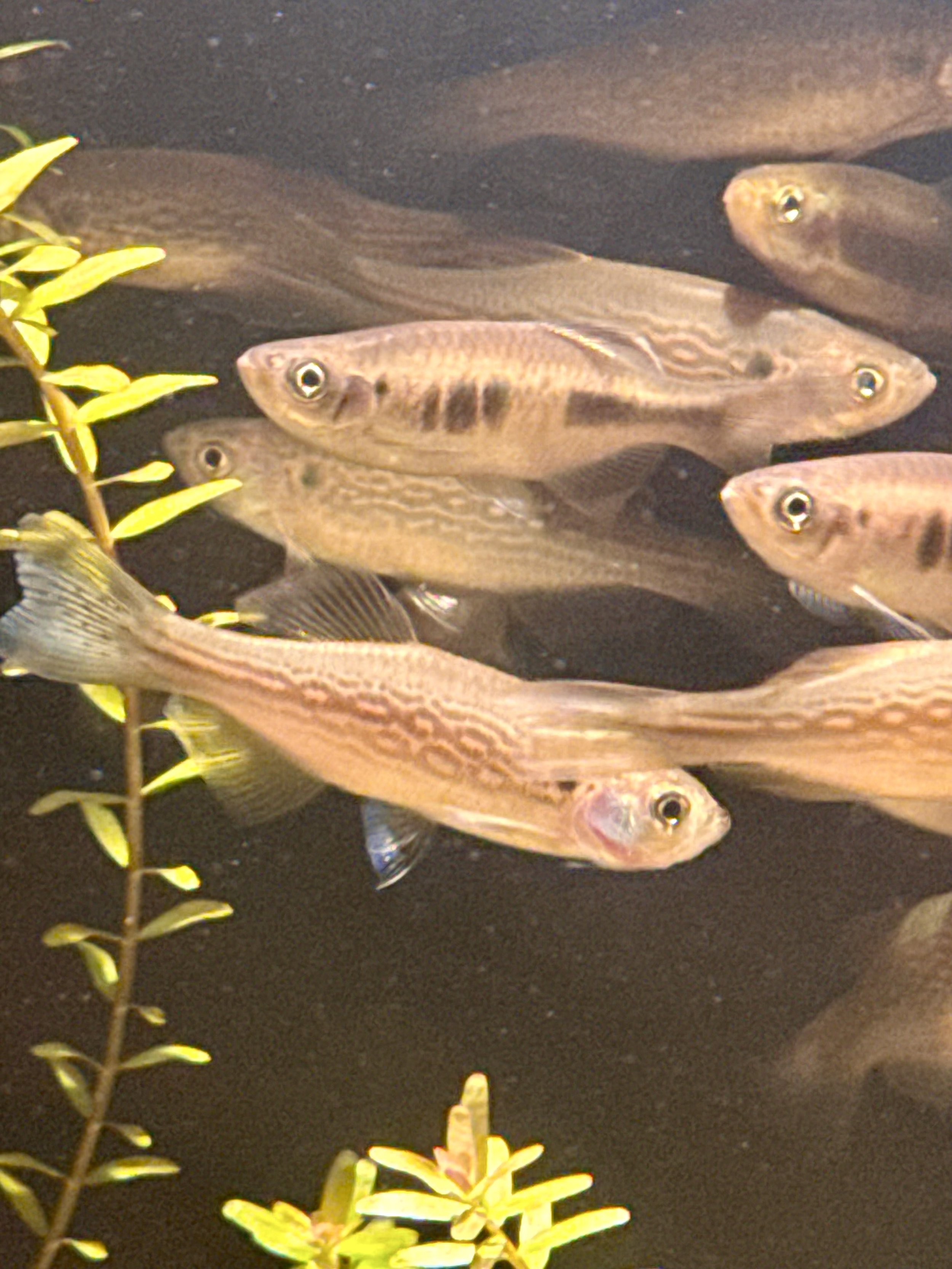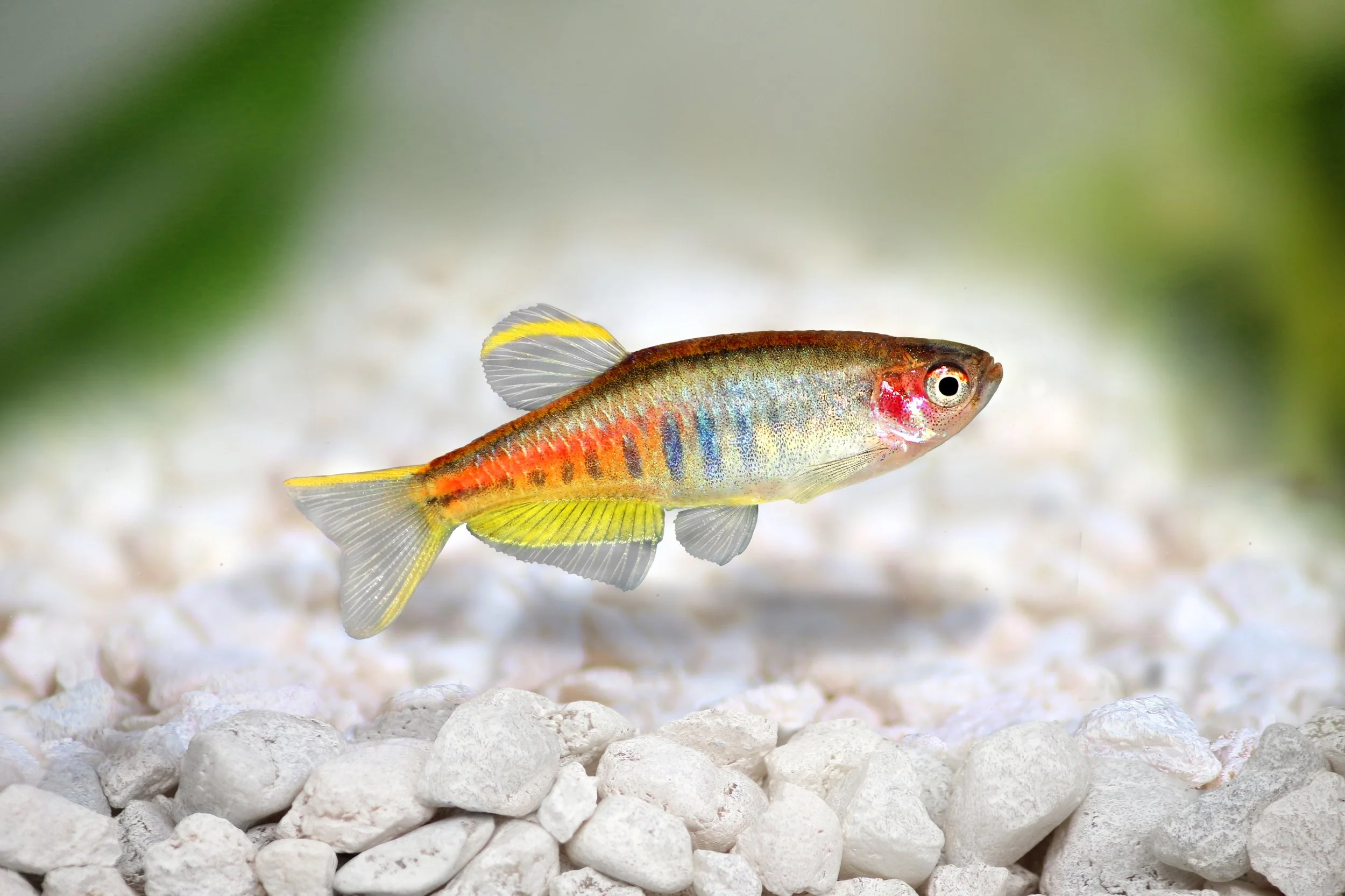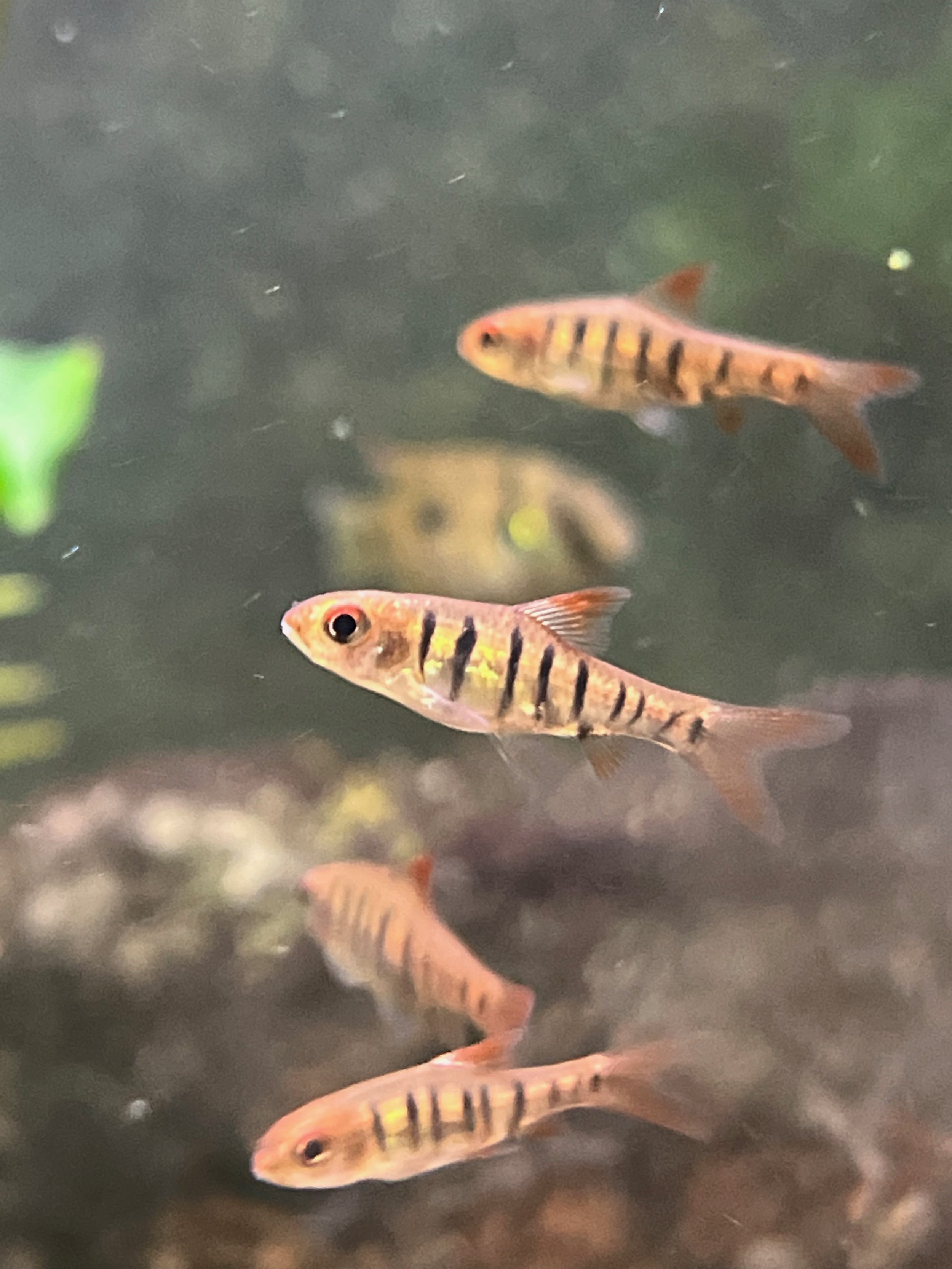 Image 1 of
Image 1 of


Rose Danio
The Rose Danio, scientifically known as Danio roseus, is a small, lively species of fish native to freshwater streams and rivers in Southeast Asia, particularly found in parts of India and Myanmar. It is recognized for its vibrant coloration and peaceful demeanor, making it a popular choice for community aquariums.
Adult Rose Danios typically reach about 1.5 to 2 inches (3.8 to 5 cm) in length. They are distinguished by their striking rose-colored body, which ranges from pale pink to deeper red hues. Their slender, torpedo-shaped body is accentuated by metallic blue or silver accents along the sides, and their small size makes them an excellent option for nano aquariums or smaller community tanks.
A tank of at least 10 gallons is suitable for a small group of Rose Danios. Like most danios, they should be kept in groups of six or more to encourage natural schooling behavior and reduce stress. The aquarium should feature plenty of open swimming space along with plants, rocks, and driftwood to offer hiding spots and create a natural environment.
Water parameters for the Rose Danio should include a temperature range of 68 to 78°F (20 to 25°C), a pH of 6.5 to 7.5, and soft to moderately hard water. They are adaptable to a range of water conditions but thrive in stable, well-maintained environments.
Feeding Danio roseus is easy, as they are omnivorous and accept a variety of foods. Offer high-quality flake food, micro pellets, and supplement with live or frozen foods like daphnia, brine shrimp, and cyclops. They will also graze on algae and plant matter in the tank.
The Rose Danio is a peaceful species that does well in community tanks with other small, non-aggressive fish such as other danios, tetras, and small rasboras. Avoid keeping them with larger or more boisterous species that may cause stress or intimidate them.
Breeding Danio roseus in captivity is possible but rare. Like most danios, they are egg scatterers and do not provide parental care. A separate breeding tank with dense plants or spawning mops is recommended to encourage breeding. After eggs are laid, the adults should be removed to prevent them from eating the eggs.
Danio roseus (Rose Danio) is a colorful and hardy species, perfect for peaceful community aquariums, adding both color and activity to any tank.
Photo by Lerdsuwa, cropped from the original, licensed under CC BY-SA 4.0.
The Rose Danio, scientifically known as Danio roseus, is a small, lively species of fish native to freshwater streams and rivers in Southeast Asia, particularly found in parts of India and Myanmar. It is recognized for its vibrant coloration and peaceful demeanor, making it a popular choice for community aquariums.
Adult Rose Danios typically reach about 1.5 to 2 inches (3.8 to 5 cm) in length. They are distinguished by their striking rose-colored body, which ranges from pale pink to deeper red hues. Their slender, torpedo-shaped body is accentuated by metallic blue or silver accents along the sides, and their small size makes them an excellent option for nano aquariums or smaller community tanks.
A tank of at least 10 gallons is suitable for a small group of Rose Danios. Like most danios, they should be kept in groups of six or more to encourage natural schooling behavior and reduce stress. The aquarium should feature plenty of open swimming space along with plants, rocks, and driftwood to offer hiding spots and create a natural environment.
Water parameters for the Rose Danio should include a temperature range of 68 to 78°F (20 to 25°C), a pH of 6.5 to 7.5, and soft to moderately hard water. They are adaptable to a range of water conditions but thrive in stable, well-maintained environments.
Feeding Danio roseus is easy, as they are omnivorous and accept a variety of foods. Offer high-quality flake food, micro pellets, and supplement with live or frozen foods like daphnia, brine shrimp, and cyclops. They will also graze on algae and plant matter in the tank.
The Rose Danio is a peaceful species that does well in community tanks with other small, non-aggressive fish such as other danios, tetras, and small rasboras. Avoid keeping them with larger or more boisterous species that may cause stress or intimidate them.
Breeding Danio roseus in captivity is possible but rare. Like most danios, they are egg scatterers and do not provide parental care. A separate breeding tank with dense plants or spawning mops is recommended to encourage breeding. After eggs are laid, the adults should be removed to prevent them from eating the eggs.
Danio roseus (Rose Danio) is a colorful and hardy species, perfect for peaceful community aquariums, adding both color and activity to any tank.
Photo by Lerdsuwa, cropped from the original, licensed under CC BY-SA 4.0.
The Rose Danio, scientifically known as Danio roseus, is a small, lively species of fish native to freshwater streams and rivers in Southeast Asia, particularly found in parts of India and Myanmar. It is recognized for its vibrant coloration and peaceful demeanor, making it a popular choice for community aquariums.
Adult Rose Danios typically reach about 1.5 to 2 inches (3.8 to 5 cm) in length. They are distinguished by their striking rose-colored body, which ranges from pale pink to deeper red hues. Their slender, torpedo-shaped body is accentuated by metallic blue or silver accents along the sides, and their small size makes them an excellent option for nano aquariums or smaller community tanks.
A tank of at least 10 gallons is suitable for a small group of Rose Danios. Like most danios, they should be kept in groups of six or more to encourage natural schooling behavior and reduce stress. The aquarium should feature plenty of open swimming space along with plants, rocks, and driftwood to offer hiding spots and create a natural environment.
Water parameters for the Rose Danio should include a temperature range of 68 to 78°F (20 to 25°C), a pH of 6.5 to 7.5, and soft to moderately hard water. They are adaptable to a range of water conditions but thrive in stable, well-maintained environments.
Feeding Danio roseus is easy, as they are omnivorous and accept a variety of foods. Offer high-quality flake food, micro pellets, and supplement with live or frozen foods like daphnia, brine shrimp, and cyclops. They will also graze on algae and plant matter in the tank.
The Rose Danio is a peaceful species that does well in community tanks with other small, non-aggressive fish such as other danios, tetras, and small rasboras. Avoid keeping them with larger or more boisterous species that may cause stress or intimidate them.
Breeding Danio roseus in captivity is possible but rare. Like most danios, they are egg scatterers and do not provide parental care. A separate breeding tank with dense plants or spawning mops is recommended to encourage breeding. After eggs are laid, the adults should be removed to prevent them from eating the eggs.
Danio roseus (Rose Danio) is a colorful and hardy species, perfect for peaceful community aquariums, adding both color and activity to any tank.





